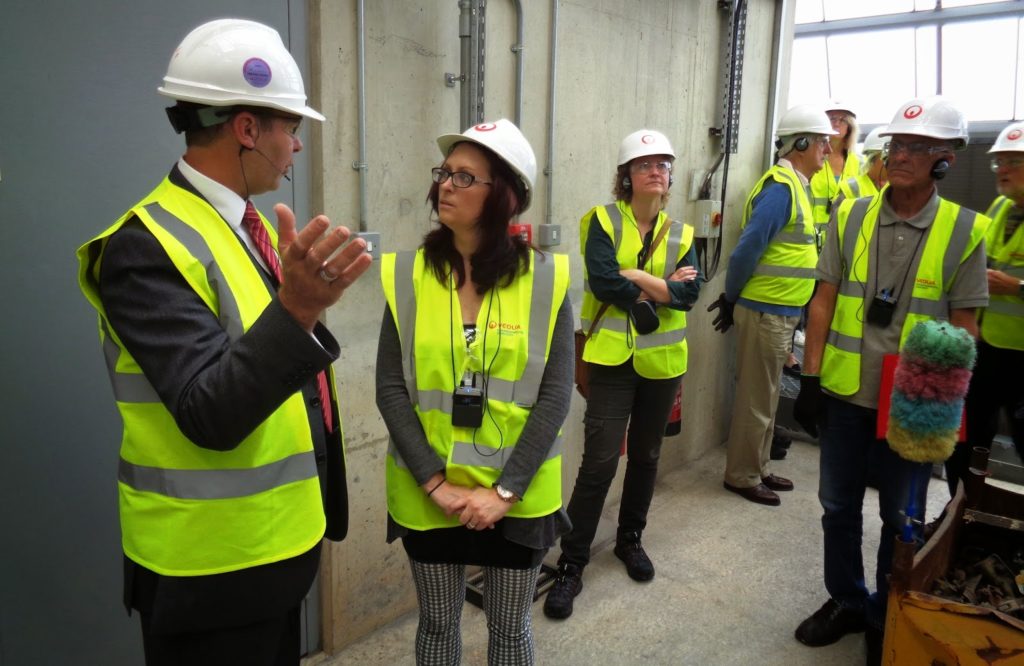On Wednesday 3rd September, the RSA Staff team visited the local Energy Recovery Facility in Newhaven. As part of their annual “Wonder Day”, the ERF Newhaven organises tour, an opportunity that the team did not miss.
This tour was the first of a series of local visits aimed at discovering the variety of Seaford’s local industries.
So, what exactly is an Energy Recovery Facility?
Basically, it is a gigantic incinerator.
The ERF was built in 2011 in Newhaven, East Sussex; a couple of miles away from the RSA headquarters. It burns approximately 28 tonnes of waste per hour, over 210,000 tonnes per year. This state-of-the-art facility provides enough power to supply 25,000 homes (the electricity produced is supplied to the National Grid). Forty people are actively working on the site. Waste is treated from Monday to Saturday morning.
 |
| Main entrance of the ERF Newhaven |
In order not to alter the South Downs landscape, the ERF Newhaven is the only one in the UK to be partially built underground. Nonetheless their 65 meters chimneys are quite visible from the surrounding areas.
On this bright morning of September the team was ready to ramble and learn more about green energy and recycling. They will soon know what happens to their household waste and old furniture!
 |
| The complete RSA Staff team with a hat on. |
The tour was led by Philipp Preece, enthusiastic Manager of the ERF. After a brief introductory speech detailing important safety measures, the group headed to the Control Room. Around 5 people work in this room mainly divided in three parts.
The first window looked out on the trucks that bring local waste to be burned. Waste is collected and unsuitable waste screened out before it arrives at the facility. Glass, metal, batteries and gas canisters are removed.
The second window offered a panoramic view of an immense hole in which the trucks unload their shipments. Waste is piled up and mixed up by a massive grabber. Once the waste is homogenously blended, are sent directly to the incinerators. The ashes are then collected and sent to a facility in the North of the UK where it is transformed into a form of concrete. The cycle of life, from a plastic bag’s point of view.
Finally the third part was the monitoring desk, at the very heart of the room. Two engineers were checking thoroughly the screens, controlling the level of toxic gases emanating from the combustion. In short, if filters do their work only non-odorous steam is released to the atmosphere and very little of that.
To produce electricity, the heat from the combustion is transformed into vapour which is then sent to turbines. The residual smoke is then filtered by hectometres of high-tech filters. The smoke from the chimneys is harmless to both humans and the environment.
 |
| Sally Hardy, CEO of the Regional Studies Association listening to Philipp Preece, Manager of the ERF Newhaven |
During the tour, Sally Hardy asked relevant questions on recycling policies in the UK since they vary upon local authorities’ decision and priorities.
Philip Preece then guided the group to the core of the facility which was surprisingly quiet. The visitors had a chance to take a look at the furnace in which waste burns at more than 5000 Celsius degree, to see how metal was removed from the residual ashes and more. A sort of “behind the scenes” of the local Energy Recovery Facility.
At the end of the visit the team was offered bags of compost made out of local gardening waste. Good news for all of the office part-time gardeners, definitely the jewel in the crown.
